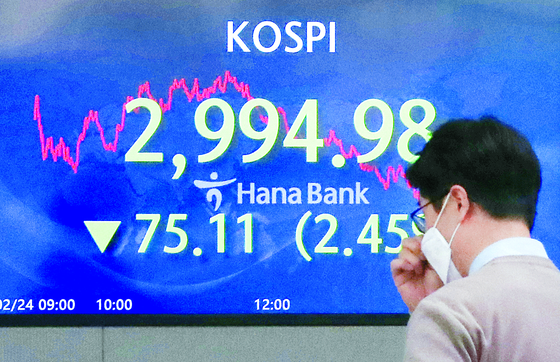![On the 24th, the KOSPI fell 2.45% (75.11 points) on the display board in the dealing room of Hana Bank's Myeongdong branch in Jung-gu, Seoul, indicating 2994.98. [뉴스1]](https://i0.wp.com/pds.joins.com/news/component/htmlphoto_mmdata/202102/25/af187cdc-5372-438d-9cc1-4e1c25a30b15.jpg?w=560&ssl=1)
On the 24th, the KOSPI fell 2.45% (75.11 points) on the display board in the dealing room of Hana Bank’s Myeongdong branch in Jung-gu, Seoul, indicating 2994.98. [뉴스1]
The KOSPI plunged more than 2% and the 3000 line collapsed. The rise in US Treasury yields aroused anxiety among investors, and the move to raise the stock exchange tax in Hong Kong was also a bad thing. It has been about four weeks since the 29th of last month (2976.21) that the KOSPI was pushed below the 3000 line. The KOSDAQ index fell by more than 3%, and the 900 index level became unsafe.
U.S. Treasury Bond’butterfly effect’ financial market fluctuations
Inflation concerns overlap with economic stimulus
Global lump sum, signs of stock market churn
Asian stocks downhill all at once
Hong Kong stock exchange tax hike is also a bad thing
On the 24th, the KOSPI ended at 2994.98, down 2.45% (75.11 points) from the previous day. Foreigners net sold about 430 billion won, leading the index decline. Major Asian markets such as Shanghai in China (-1.99%), Tokyo in Japan (-1.61%) and Hong Kong (-2.99%) also fell at the same time. On this day, the won in the Seoul foreign exchange market ended at 1112.2 won per dollar, down 1.6 won from the previous day. The KOSDAQ index plunged 3.23% to 906.31, closing the deal.
In recent global financial markets, there are signs of a change in the huge flow of funds. The consensus about the preference for risky assets, which was formed among global investors after the US presidential election in November last year, is weakening. At the end of last year, the weakness of the dollar and the strength of emerging economies’ currencies was remarkable. However, this year, the value of the dollar is slightly stronger compared to the end of last year. On the contrary, the value of the won turned downward after peaking on the 4th of last month (1082.1 won per dollar). Recently, it is traded at around 1110 won per dollar.
Under these circumstances, rising US Treasury yields signal global investors to reduce their share of risky assets such as stocks. The US 10-year Treasury bond rate, which fell to the 0.7% level in November last year, has recently risen to the 1.3% level. This means that the demand for borrowing dollars has increased in the US financial market, but the demand for borrowing dollars has not been met. ▶ This is because the Joe Biden administration has announced a plan to boost economic stimulus through issuance of enormous government bonds. Park Seok-joong, a researcher at Shinhan Investment Corp. said, “As the US 10-year Treasury bond rate is close to the top of this year’s forecast (1.5% per year), it is highly likely to put a burden on the domestic stock market in the short term.”

US Treasury Butterflies Effect
There have been expectations among global investors that the US central bank, the Federal Reserve System (Fed), will release additional money to curb the rise in government bond yields. This will also make it easier for the Biden administration to launch a large-scale stimulus package. However, the Fed is not moving in the direction investors want. It is unlikely that the Fed will raise its benchmark interest rate for the time being, but it is also not trying to release additional money. With the Fed, it is possible to worry about the situation where the pressure to increase inflation becomes unbearable after loosening more money.
In the domestic financial market, the interest rate of government bonds is shaken. It is inevitable for the government to issue large-scale government bonds in order to raise the 4th disaster support fund. If the supply of government bonds in the market increases, the price of government bonds will inevitably decrease (the interest rate rises). According to the Financial Investment Association, the 3-year Treasury bond rate, which is an indicator of the market interest rate, recorded 1.020% per annum on the 23rd. On the 24th, it fell to 1.006% per year, but it is still high compared to the lowest point in August last year (0.795% per year). On the 24th, the 10-year Treasury bond rate ended at 1.851% per year.
Yoon Yeo-sam, a researcher at Meritz Securities, said, “When considering the rise in US Treasury yields, we should keep the top of 10-year Korean Treasury Bond yields open to around 2% per year.”
On the 24th, the news that Hong Kong will increase the stamp duty on securities transactions from 0.1% to 0.13%, the stock market sentiment worsened. Lee Won, a researcher at Bukook Securities, said, “It seems that issues such as an increase in Hong Kong stamp duty have been a negative factor in the burden of rising US Treasury rates.
Reporters Eui-Young Hwang and Ki-Hwan Kim [email protected]
![]()
